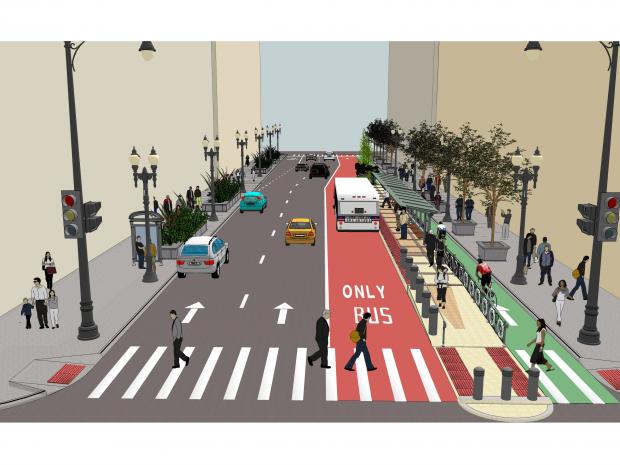Utah is undergoing a quiet but powerful transformation in its urban landscape, where safety, sustainability, and accessibility are no longer afterthoughts—they are leading the design process. With increasing demand for walkable, livable cities, Utah’s embrace of colored bike and bus lanes is proving to be a catalyst for urban revitalization. These brightly hued corridors do far more than add aesthetic appeal; they anchor a comprehensive approach to safe streets infrastructure that is rapidly reshaping public spaces across the state.
From Salt Lake City’s ambitious traffic redesigns to smaller municipalities like Moab and Logan adopting traffic calming innovations, Utah is emerging as a model for how bold visual cues, paired with smart design, can address long-standing urban challenges. This blog dives into how colored bike and bus lanes benefits ripple far beyond paint and pavement—fostering safer streets, cleaner air, and more vibrant communities.
A Safety-First Approach to Mobility
Colored bike and bus lanes are not merely stylistic choices—they are strategic interventions. In the realm of Utah traffic calming solutions, color has become a silent enforcer of safety. By visually distinguishing specific portions of the roadway, especially with red for bus lanes and green for bike lanes, cities reduce the ambiguity that often leads to accidents between motorists, cyclists, and pedestrians.
Salt Lake City has been at the forefront of this movement, integrating green bike lanes along major corridors like 300 South and 200 West. The city has reported a noticeable drop in cyclist-motorist conflicts on these roads, with clearer delineation making it easier for drivers to respect the designated zones. Green bike lanes, often paired with vertical delineators and raised curbs, not only improve visibility but also increase compliance. Meanwhile, red bus-only lanes streamline mass transit and deter unauthorized vehicles, enhancing overall road efficiency and reducing travel times for transit riders.
These efforts align with Vision Zero principles, an international initiative aimed at eliminating all traffic fatalities. Utah’s colored lane adoption is consistent with a growing body of evidence showing that dedicated and colored lanes significantly reduce injury rates by separating modes of travel and slowing vehicle speeds. In a region long dominated by car culture, this shift toward safe streets infrastructure signals a powerful commitment to public safety and mobility equity.
Designing for a Greener Tomorrow
Beyond safety, colored lanes are central to Utah’s pursuit of eco-friendly street design. Encouraging cycling and public transportation helps reduce carbon emissions, noise pollution, and urban heat island effects. With climate-consciousness becoming a political and social imperative, these lanes function as a green infrastructure solution that pays dividends over time.
Utah’s urban planners are integrating bike and bus lanes into a broader network of sustainable mobility solutions. The Bus Rapid Transit (BRT) system in Provo-Orem, for instance, includes red-colored lanes that ensure buses move efficiently through dense traffic while minimizing emissions. This complements Utah Transit Authority’s commitment to low-emission buses and electrified transport.
At the same time, expanding bike networks in cities like Ogden and Park City is encouraging more people to choose two wheels over four. These routes aren’t just for recreation—they’re increasingly used for commuting, errands, and school transport. The consistent use of green coloring across cities helps normalize and legitimize cycling as a serious mode of travel, thus enhancing adoption and long-term cultural shift toward sustainability.
Moreover, colored lanes can be constructed with environmentally conscious materials such as low-VOC paints or permeable pavement that reduces stormwater runoff. When combined with greenery, bioswales, and shade structures, these features contribute to a holistic eco-friendly street design that combats urban blight and climate risks.
Revitalization Through Design and Identity
Perhaps one of the most overlooked benefits of colored bike and bus lanes is their role in sparking placemaking and urban identity. Color injects vibrancy into otherwise monotonous asphalt landscapes, inviting people to engage with their environment. This visibility doesn’t just aid navigation—it builds confidence among cyclists and bus riders, encouraging broader usage and reducing dependency on private vehicles.
Urban revitalization efforts in Utah’s downtowns are increasingly anchored around multimodal transportation hubs. In Salt Lake City, the “Life on State” initiative aims to transform the once car-centric corridor into a pedestrian- and transit-friendly destination. Colored lanes are central to this vision, acting as connective tissue between economic zones, cultural landmarks, and residential areas.
Similarly, in smaller cities such as St. George and Logan, local leaders are discovering that best colored bike and bus lanes are not just tools for mobility, but engines for economic renewal. By calming traffic and creating safe access to shops and parks, these lanes help drive foot traffic and encourage local spending. Businesses benefit from slower streets and higher visibility, while residents enjoy a safer, more accessible urban environment.
Color also plays a critical role in creating a sense of continuity across infrastructure projects. When travelers see green lanes consistently across cities, it reinforces the idea that cycling is a viable and supported choice everywhere. This coherence makes urban navigation easier, especially for new riders or tourists, and contributes to a more intuitive and welcoming city layout.
Accessibility and Equity in Urban Mobility
A truly revitalized city is one that serves all its residents, not just those who can afford cars or live near transit-rich neighborhoods. Colored lanes are helping bridge longstanding gaps in accessibility by visually and functionally democratizing street space.
In historically underserved areas, new safe streets infrastructure projects have begun prioritizing transit and cycling as core mobility solutions. This shift is most visible in neighborhoods where residents rely heavily on public transportation or walk and bike due to economic necessity. By adding clearly marked bus and bike lanes, cities are leveling the mobility playing field and enhancing transportation justice.
Additionally, these improvements often accompany ADA-compliant curb ramps, improved lighting, wayfinding signage, and extended sidewalks—all of which enhance access for people with disabilities and seniors. This comprehensive approach to urban design ensures that colored lanes are not standalone elements, but part of a greater effort to build streets that work for everyone.
Utah’s investment in inclusive mobility is also reflected in public engagement strategies. City planning departments are involving local communities in the design process through surveys, town halls, and temporary installations like tactical urbanism pilots. This participatory model ensures that infrastructure improvements reflect the needs and desires of diverse populations, and that residents feel ownership over their streetscape.
Measuring the Ripple Effects
As these projects proliferate, their success is being measured not just in miles of painted lanes, but in the health, safety, and vitality of communities. Studies in Salt Lake City have documented reduced vehicle speeds and increased cycling volumes along corridors with green bike lanes. Red bus lanes have improved on-time transit performance, particularly during peak hours. Together, these improvements deliver clear colored bike and bus lanes benefits that can be tracked over time.
Public health metrics also point to gains: better air quality from reduced vehicle emissions, increased physical activity from cycling and walking, and fewer traffic-related injuries. Economically, cities are reporting rising property values near new infrastructure, along with increased retail foot traffic. These trends are encouraging further investment from both public and private sectors, reinforcing the idea that street design is not a sunk cost, but a high-return investment.
Importantly, the ongoing success of these initiatives requires maintenance, education, and enforcement. Cities like Provo are experimenting with automated enforcement for bus lane intrusions, while others are launching safety campaigns to inform the public about how to interact with the new infrastructure. Long-term success depends on continual adaptation and robust data collection to fine-tune designs and maintain public trust.
Conclusion
As Utah continues this journey, it becomes a compelling example of how Utah traffic calming solutions can drive not just better transportation, but a stronger, more resilient urban future. Colored bike and bus lanes are more than a fresh coat of paint—they are symbols of a state rethinking what a street can be, and who it should serve. The result? Safer streets, stronger cities, and a blueprint worth following.






